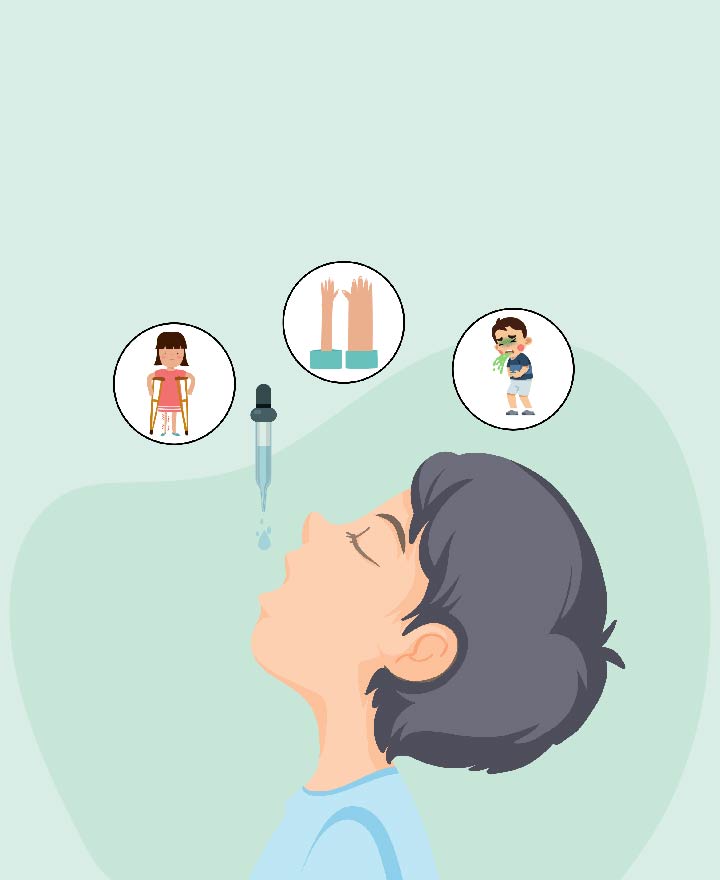

Polio - Symptoms, Causes and Treatment
Polio is a disease caused by the poliovirus which affects children and may even leave them paralysed. While most types of polio have been eradicated, some forms are still active and found in certain parts of the world. The only way to stay safe against polio disease is to get vaccinated. Read on to know more.
What is Polio?
Poliomyelitis, commonly known as polio disease, is a dangerous, life-threatening disease caused by a virus and can spread from person to person. The virus affects the spinal cord leaving the person either paralysed or disabled in certain parts of the body.
Types of Polio
There are different types of polio. While some are mild and do not cause any long-term health complications, others may be very severe and even turn fatal. They are:
1. Abortive poliomyelitis: This causes only mild flu-like symptoms and is not a very dangerous form of the disease.
2. Non-paralytic poliomyelitis: Here, the patient develops meningitis and may have to spend a few days in the hospital. However, the chances of recovery are high.
3. Paralytic poliomyelitis: In this, the spinal cord is affected by the virus leading to either paralysis or disability of certain body parts.
4. Polioencephalitis: This form of polio disease affects infants and leads to brain swelling.
What Are The Symptoms of Polio?
While it is common to not show any symptoms, the severity and symptoms of polio largely depend on the spread of virus in the body. If the virus multiplies and spreads, the effect is greater. Only about 25% of the people with polio show the symptoms which include:
● Weakness
● Throat pain
● Headache
● Fever
● Stomach upset
● Vomiting
● Body ache
What Causes Polio?
Polio is caused by viruses that can transmit from an infected person when in direct contact.It is important to quarantine the infected person so that the virus doesn't spread. However, vaccinated people are safe.
How Is Polio Diagnosed?
Polio can be diagnosed through blood, urine, and stool sample tests. Apart from this, the doctor may ask you questions about your symptoms, travel history and vaccination records to make a correct diagnosis.
Polio Treatment
There is no treatment for polio but the vaccines available can keep you and your child safe. If you get infected, healthcare providers will advise physical therapy basis your symptoms, medications for pain relief and taking enough rest to avoid discomfort.
Types of Polio Vaccines
Polio vaccines are usually given to children and they are administered orally in 4 rounds – at the age of 2 months, 4 months, between the age of 6 and 18 months, and finally between the age 4 to 6 years.
For adults who missed their vaccination, first 2 doses are given at an interval of two months followed by 3rd dose after 12 months.
Conclusion
Polio is a viral disease that can be dangerous but fortunately it can be prevented through vaccines. So all you need to do is get yourself and your child vaccinated so as to ensure a safe and healthy life.
One of the important components of our overall wellness is also being financially secured. Healthcare emergencies can happen any time, but a good health insurance can protect you from such uncertain situations. To know more about it, click here
Source: Cleveland, Webmd, CDC
Disclaimer: This blog provides general information and discussions about health and related subjects. The information and other content provided in this blog, website or in any linked materials are not intended and should not be considered, or used as a substitute for, medical advice, diagnosis or treatment. Kindly contact your Doctor before starting a new medicine or health regime.
Related Articles
What Is ADHD And How To Diagnose Amongst Children And Adults
Anxiety In Children – What You Need To Know
Boosting Your Child's Immunity - Here's How You Can Do It!
A Deep Dive into Why You Need to Get Family Health Insurance Today
Family Health Insurance or Individual Health Plans – What to Choose?
Published on April 24, 2023

















 Health Insurance
Health Insurance  Travel Insurance
Travel Insurance  Car Insurance
Car Insurance  Cyber Insurance
Cyber Insurance  Critical Illness Insurance
Critical Illness Insurance
 Pet Insurance
Pet Insurance
 Bike/Two Wheeler Insurance
Bike/Two Wheeler Insurance  Home Insurance
Home Insurance  Third Party Vehicle Ins.
Third Party Vehicle Ins.  Tractor Insurance
Tractor Insurance  Goods Carrying Vehicle Ins.
Goods Carrying Vehicle Ins.  Passenger Carrying Vehicle Ins.
Passenger Carrying Vehicle Ins.  Compulsory Personal Accident Insurance
Compulsory Personal Accident Insurance  Travel Insurance
Travel Insurance  Rural
Rural